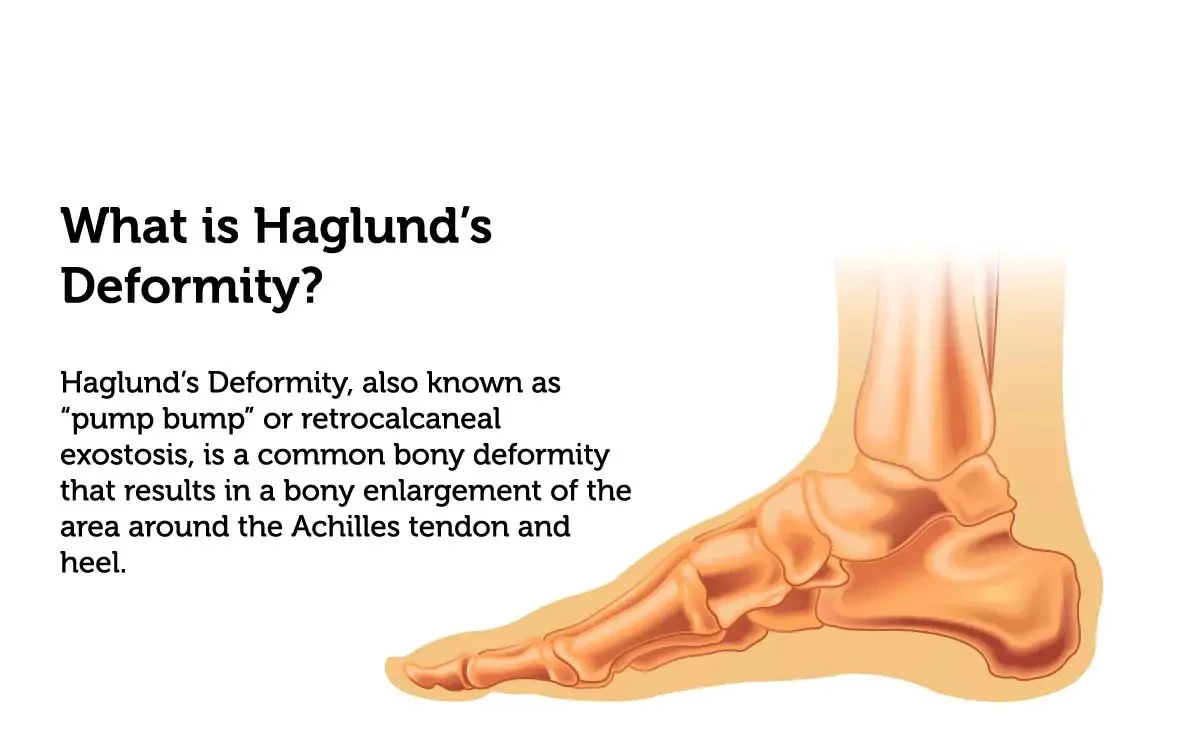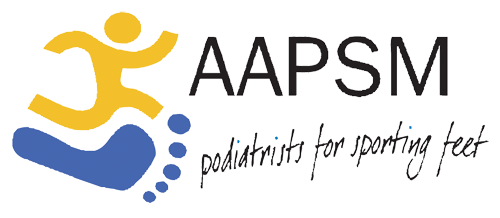Haglund’s Deformity
Does the back of your heel feel sore, swollen, or irritated after a long day on your feet? Then you might be dealing with Haglund’s Deformity.
Defined by a bony bump that forms at the back of the heel, this condition can cause strong discomfort and pain, particularly if you spend a lot of your day wearing stiff or enclosed shoes.
It’s not the nicest sounding of conditions, which is why it is more commonly known as “pump bump”. However, it is surprisingly common. That said, the good news is that it is easily treated.
At Gold Coast Foot Centres, we specialise in helping locals find relief from this ailment. We do this by providing them with customised care plans that focus on their long-term comfort and mobility.
Regardless of whether you have developed it as a result of being on your feet all day for work or just because you like to stay active, we’re committed to helping you move free of heel pain.
What is Haglund’s Deformity?
Haglund’s Deformity is a condition where a bony enlargement forms on the back of the heel bone, specifically at the point where the Achilles tendon inserts.
It creates a prominent bump that often becomes problematic when it rubs against the inner lining of shoes. This constant pressure and friction can irritate nearby soft tissues and cause major discomfort.
One of the key structures involved is the retrocalcaneal bursa, which is a small fluid-filled sac that sits between the heel bone and the Achilles tendon. Its job is to reduce friction during movement. However, with a bony bump pressing against it, the bursa can become inflamed and therefore result in it swelling and being painful.
Although the condition can develop at any age, Haglund’s Deformity is more often seen in active adults, people who wear tight or rigid footwear, and those with certain foot shapes.
Essentially, it’s a mechanical issue that often becomes more troublesome over time, especially if you do not wear appropriate footwear that supports you well. Thankfully, the condition is not life-threatening. But if it is left unaddressed, it can affect your levels of comfort and mobility.
What Causes Haglund’s Deformity?
Haglund’s Deformity usually develops due to a combination of structural and mechanical factors. For instance, if you have a naturally high arch, the angle of your heel bone may place more pressure on the back of your foot. Over time, this stress can cause bone to build up where the Achilles tendon attaches.
Another major cause is wearing rigid or ill-fitting footwear, especially shoes with hard backs like dress shoes or high heels. That is because the repetitive rubbing and pressure from these shoes irritate the area, especially if they are worn for long periods. Indeed, a tight Achilles tendon may make things worse by pulling excessively on the heel bone, which increases the chances of inflammation and changes to the bone.
You might also be more prone to Haglund’s Deformity if someone in your family has had it or if your walking pattern puts extra stress on the heel. In fact, more often than not, it results from a combination of these factors rather than a single cause.
Common Symptoms
Typically, Haglund’s Deformity often makes itself known from a discomfort or irritation that occurs at the back of the heel, especially after walking or standing for long periods.
For many, the most noticeable sign is a visible, sometimes red or swollen bump that resides just above the heel where the Achilles tendon attaches. This bump can feel sore to the touch and may become inflamed after wearing enclosed footwear.
People frequently report pain while wearing stiff shoes, particularly those that have closed backs like school shoes, work boots or high heels. In some cases, the irritation can be bad enough to cause blisters, calluses or even small abrasions where the shoe continuously rubs against the bump.
You might also feel a burning or aching sensation in the area, particularly during or after intense or prolonged physical activity. Although symptoms may start off mild, they often escalate if the condition isn’t professionally managed early on. Moreover, if both feet are affected, then it might become hard to perform daily activities due to the levels of discomfort you are feeling.
How Do We Diagnose and Assess Haglund’s Deformity?
At Gold Coast Foot Centres, we find the easiest way to diagnose Haglund’s Deformity is to take the time to understand your experience.
We do this by starting with a friendly discussion about your symptoms, daily routine, footwear choices and medical history. This helps us get a clear picture of how your condition may have developed and what might be aggravating it.
After doing this, we then conduct a hands-on physical examination to check for swelling, tenderness, and visible signs like the telltale heel bump. We will also assess how your feet move, as well as your gait and the alignment of your heel and ankle.
To ensure we have made a correct diagnosis, we may take X-rays of the affected foot, as this will help us to visualise any bony enlargement. However, if we suspect inflammation or soft tissue involvement, we might recommend an ultrasound or MRI. These imaging tools help us assess the retrocalcaneal bursa and Achilles tendon more closely.
Once we have a full understanding of your condition, we will then design a personalised treatment plan for you that targets and relieves the source of your discomfort.
Non-Surgical Treatment Options
You’ll be pleased to read that in most cases, Haglund’s Deformity can be managed effectively without surgery.
At Gold Coast Foot Centres, our podiatrists focus on relieving pressure and inflammation by providing our patients with targeted conservative care. One of the first things we do is recommend changes to their footwear. For instance, just by wearing soft-backed or open-heeled shoes, it can significantly reduce friction and allow the affected area to settle down.
Additionally, we may prescribe heel lifts and custom orthotics to improve your alignment and reduce strain on the Achilles tendon.
If you are experiencing inflammation, this can be eased with ice packs, rest and over-the-counter anti-inflammatory medication. We also offer several physical therapy options, including exercises to stretch and strengthen the calf and Achilles region.
When is Surgery Needed?
Surgery for Haglund’s Deformity is usually only considered after non-surgical treatments have been exhausted without success.
After this time, surgery may be considered if you’re still experiencing significant pain or restricted movement despite wearing better shoes and using orthotics.
The procedure typically involves removing the bony prominence at the back of the heel to stop it from irritating nearby tissues. In some cases, your podiatric surgeon may also need to address damage to the Achilles tendon or remove an inflamed bursa. The goal here is to relieve pressure, restore movement and function, and improve your levels of comfort over the long term.
If surgery is required, recovery can take several weeks. You may also need time off work, especially if your job is physically demanding. Typically, post-op care includes rest, gradual rehabilitation, and physiotherapy, which are all designed to help you make a full return to normal activity.
Managing Haglund’s Deformity Long-Term
Once the symptoms settle, it’s important to stay on top of your foot health in the long term. We help patients manage their Haglund’s Deformity by:
Recommending appropriate footwear
Offering orthotics tailored to your gait
Educating you on foot biomechanics, strength and stretching
Providing ongoing care to prevent recurrence and support a pain-free, active lifestyle.
Why Choose Gold Coast Foot Centres?
At Gold Coast Foot Centres, we combine years of clinical expertise with a warm, local approach to podiatry.
We understand how frustrating chronic heel pain can be, and we’re committed to delivering solutions that actually work. That is why our clinic uses evidence-based treatments that are tailored to your lifestyle, whether you love to exercise on weekends or are on your feet all day at work.
We don’t believe in one-size-fits-all care. Instead, we take the time to assess your unique foot mechanics and provide practical, long-term strategies that will provide you with relief. From our customised orthotic prescription to ongoing rehabilitation support, we’re here every step of the way.
Book an Appointment Today
Think you might have Haglund’s Deformity? Don’t let the heel pain slow you down.
Instead, please book a consultation at one of our Gold Coast Foot Centre locations today.
Our friendly podiatrists are ready to help you get back on your feet.
Frequently Asked Questions
-
The bony growth won’t disappear, but symptoms can improve significantly with the right treatment.
-
With conservative treatment, many people feel better in a few weeks. Surgery recovery can take a couple of months.
-
Yes. But you may need to modify certain activities to reduce pressure on the heel. We can help you plan safe movement.
-
Ignoring the symptoms can lead to worsening pain, Achilles damage or bursitis. That is why early care is so important because it helps prevent complications.





